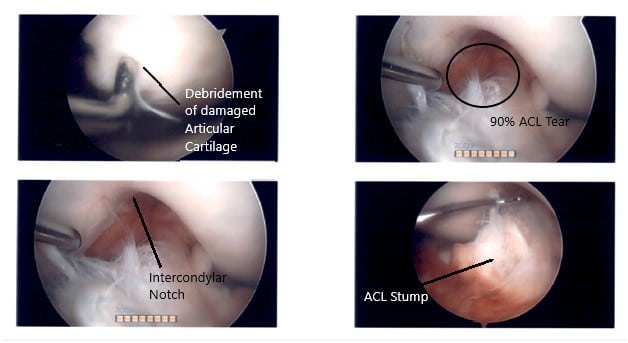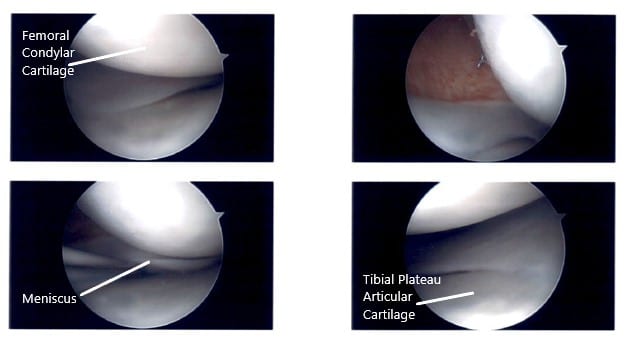Case Study: Anterior Cruciate Ligament (ACL) Reconstruction
and Chondroplasty of the Left Knee in a 30-year-old Female
The patient is in our office, with complaints of left knee pain for the past 2 months. The patient states she can not put weight on the left knee, the patient is also limping. The pain is mild to moderate in intensity. The patient describes the pain as sharp and dull.
The pain is intermittent. The pain is associated with swelling and limping. The pain is not associated with bruising, tingling, numbness, radiating pain, weakness, bowel or bladder abnormality, gait problem, giving way, or hand function difficulty. The problem has been getting better since it started.
Conservative treatment like icing, knee braces, and ibuprofen make the symptoms better. The patient has undergone no surgery. The patient has no medical history. The patient is allergic to cat hair. The patient is currently taking tonsil medication. The patient does not smoke.
Upon examination of the left knee, there is no ecchymosis, abrasions, or lacerations. There is a 2+ knee effusion. There is no pain with palpation along the medial or lateral border of the patella. The active range of motion is limited secondary to pain, but the patient is able to fully extend the knee and flex to 90 degrees. The passive range of motion is similar to active.
There is no crepitation throughout the range of motion. There is no pain to palpation along the medial or lateral femoral epicondyle. Palpation along the medial or lateral joint lines does not reproduce pain.
McMurray’s maneuver produces generalized knee pain but no joint line-specific pain. Collateral ligaments are intact to varus/valgus stress. There is a 3+ Lachman. Pivot shift test cannot be performed secondary to pain. The posterior drawer is negative. Dial test is negative. There is no soft tissue swelling distally. The neurocirculatory examination is intact.
On examination of the contralateral extremity, the patient is non-tender to palpation and has an excellent range of motion, stability, and strength.
MRI was done, which showed buckling as well as possible tear of the ACL. Various treatment options were discussed with the patient and she opted for arthroscopic examination and possible treatment in the form of debridement, repair, reconstruction as needed. The patient understood and signed informed consent.
PREOPERATIVE DIAGNOSIS: ACL tear of the left knee.
POSTOPERATIVE DIAGNOSES:
- ACL tear of the left knee.
- Grade 1 to grade 2 arthritis of the patella as well as medial femoral condyle.
OPERATION:
- Chondroplasty left knee, arthroscopic chondroplasty of the patella as well as medial femoral condyle.
- Arthroscopic reconstruction of the ACL using quad tendon autograft.
PROCEDURE: The patient was taken to the operating room where he was placed on a well-padded operating room table. General anesthesia was induced. The left lower extremity was prepped and draped aseptically. Preoperative antibiotics were given.
Tourniquet was elevated. The arthroscopic examination was done from the lateral entry border. A medial entry portal was also made. There was grade 2 to grade 3 arthritis on the medial femoral condyle, which was cleaned by shaver. There was grade 2 to grade 3 arthritis on the patella, which was cleaned by the shaver, medial as well as a lateral meniscus tear.
Intraoperative Arthroscopic Images of the left knee.
Examination of the intercondylar notch there was a 90% tear of the ACL, which was decided to be reconstructed and it was not repairable. Debridement of the ACL was done. There were some fibers of the posterior ACL was left intact to allow for proprioception. The quad tendon was harvested through a midline suprapatellar incision by using the quad tendon harvesting kit 8 mm x 10 mm x 75 mm of the graft was repaired by putting FiberLinks on either side.
Intraoperative Arthroscopic Images of the left knee.
Arthroscopic debridement of ACL foot stump was performed on the medial surface of the lateral condyle of the femur as well as ACL footprint. ACL guide was used to allow the insertion of the flip cutter from the lateral femoral condyle through a small incision.
Intraoperative Arthroscopic Images of the left knee.
The flip cutter was used to make a tunnel of about 35 mm in the femur site. Similarly, a flip cutter was used to make a tunnel with a tibial ACL guide on the tibial side and tunnel of 25 mm. After thorough irrigation, the ACL graft was inserted using wires for shuttling into the femoral and then followed by tibia with tight rope RT up on either end.
The graft was tightened with a tightrope on either end and found to be in an acceptable position and checked by the arthroscope. The tightrope sutures were tied to each other and the shuttling suture was removed. Final pictures were taken and saved. The arthroscope was removed.
Closure of the knee was done after thorough irrigation in layers using #0 Vicryl, #2-0 Vicryl, and #3-0 Monocryl. The dressing was done using 4×4, Adaptic, ABD, Webril, and Ace wrap. Knee immobilizer was applied. The patient was then extubated. The Adductor canal femoral block was done by the anesthesia.
The patient was informed about the precautions and use of the knee mobilizers, ice, elevation, medications have given.
Disclaimer – Patient’s name, age, sex, dates, events have been changed or modified to protect patient privacy.
My name is Dr. Suhirad Khokhar, and am an orthopaedic surgeon. I completed my MBBS (Bachelor of Medicine & Bachelor of Surgery) at Govt. Medical College, Patiala, India.
I specialize in musculoskeletal disorders and their management, and have personally approved of and written this content.
My profile page has all of my educational information, work experience, and all the pages on this site that I've contributed to.




